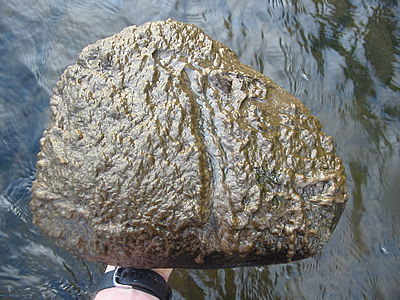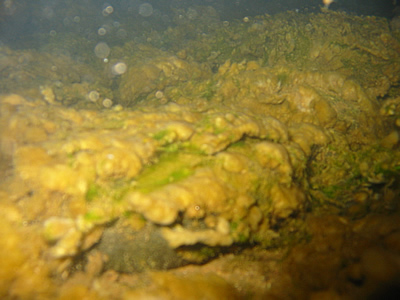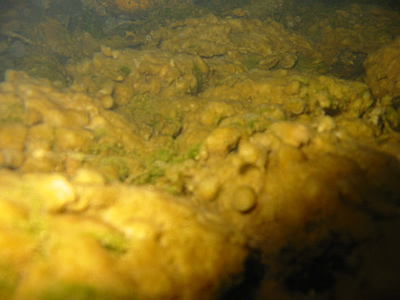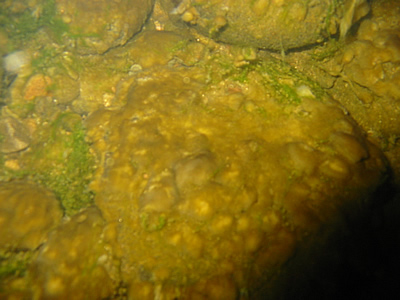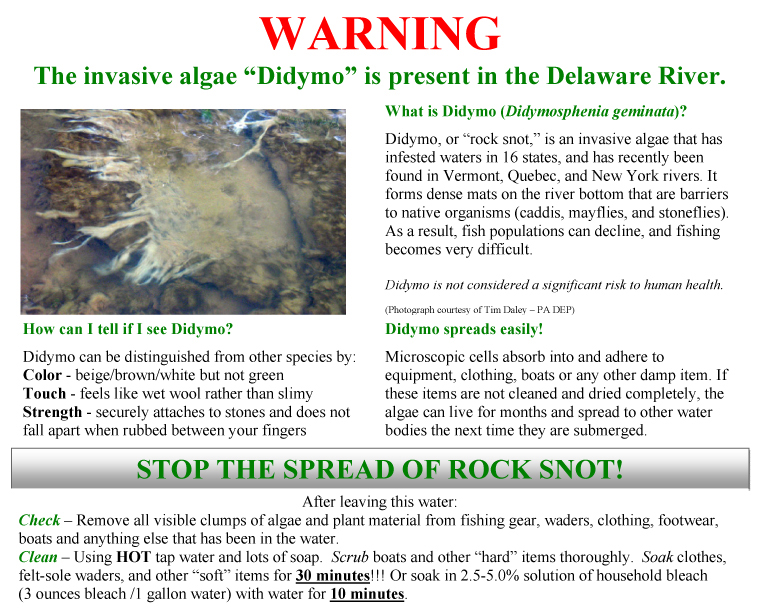Delaware • New Jersey • Pennsylvania
New York • United States of America
DRBC Video, Information, and Images of Didymo
Links for Additional Information on Didymo
What is Didymo?
Didymosphenia geminata (also known as Didymo or "Rock Snot") is an invasive, aquatic alga that can form extensive mats in streams, rivers, lakes, and other freshwater systems. Its blooms have been most problematic in cold streams and rivers, particularly low-nutrient trout waters, where Didymo and its long stalks can blanket the streambed, rock surfaces, and aquatic plants and thus stifle the productivity of these streams. But, to the surprise of many scientists, this species may be expanding its range into warmer environments and into higher-nutrient waters.
A single-celled type of algae in the group known as diatoms, Didymo is highly unusual because it forms long, stalked material in low nutrient waterways. These branched stalks are brown or beige in color, sometimes with white strands that resemble tissue or toilet paper. While it looks slimy, Didymo actually feels like wet wool or wet cotton. And it is the long growths of stalks, rather than the algal cells themselves, that are the problem.
It has also been found in waters that are more nutrient-rich, but it has a different appearance. The algae itself is still the same brown-beige color, but it doesn't form long stalks or thick mats, making detection of Didymo more difficult. In these higher nutrient waters, the Didymo stalks are microscopic in length, giving Didymo a more typical appearance of a brown, algal-covered rock.
Where has it been found?
The stalk-forming variety of Didymo has been found in the river since 2007, when high-density blooms with heavy stalked material were found in the East Branch and West Branch Delaware River and the mainstem Delaware River as far downstream as Callicoon, N.Y. Since 2007, low concentrations have been found during warmer summer months from around Hancock, N.Y., downstream to the area around Dingmans Ferry, Pa. During the same time period, high-density patches were frequently observed in the cold-water zones of the East and West branches of the Delaware River, as well as in the colder zones of the upper main stem river.
In April 2012, Dr. Erik Silldorff, an aquatic biologist with the commission, discovered large, stalked Didymo blooms in the Delaware River over a 40-mile stretch extending from the area near the confluence with the Lackawaxen River downstream to the vicinity of Dingmans Ferry Bridge. This section of river includes portions of two National Park units: the Upper Delaware Scenic and Recreational River (UPDE) and the Delaware Water Gap National Recreation Area (DEWA).
Additional surveys in April showed that thick mats of Didymo extended north of the area discovered by Silldorff to Callicoon, N.Y., as well as from Long Eddy, N.Y. upstream into the East and West branches of the Delaware River north of Hancock, N.Y.
Surveys completed in May 2012 discovered both varieties of Didymo south from DEWA all the way to Trenton, N.J. This section of river is known as the Lower Delaware National Wild and Scenic River. Above the Delaware's confluence with the Lehigh River in Easton, Pa., thick mats of stalked Didymo were found. Below the confluence with the Lehigh, the short-stalked variety of Didymo covered rock surfaces.
In all, Didymo had extended throughout the non-tidal portion of the Delaware River. It was also found in the Big Flat Brook, a N.J. tributary in DEWA, near its confluence with the Delaware River.
Why is there concern?
While Didymo is not a public health hazard, there is great ecological concern with discovering the invasive alga to this extent and in these concentrations. Thick mats of Didymo can crowd out or smother more biologically valuable algae growing on the riverbed, thereby significantly altering the physical and biological conditions within a stream.
Additionally, Didymo is easily spread, and the chance of it hitchhiking its way into nearby streams or rivers that currently lack this unwanted invader is cause for alarm. Because there are many cold, low-nutrient streams in the Delaware Basin and surrounding areas, the risks may be greater for these persistently cold trout streams where Didymo could bloom throughout the summer months. Keeping Didymo out of such streams is critically important.
What can be done?
Once Didymo is found in a body of water, there is no known way to fully eradicate it.
Didymo can spread naturally as its stalks lengthen and shred off into the waterbody, traveling downstream and reattaching to other rock surfaces and streambed material.
However, the main culprit for spreading Didymo is humans, through the use of recreational equipment: fishing gear (particularly felt-soled boots), kayaks, boats, life jackets, neoprene wet suits, etc.
The most important thing is containment - preventing its spread to other water bodies that do not currently have Didymo. This is done by educating the public to decontaminate their gear after use in a waterbody where Didymo is known to exist or encourage, when feasible, restricting equipment use to a single waterway. See below for links to information on how to properly clean your gear.
Steps Taken and Currently Ongoing
DRBC staff worked with scientists from Pennsylvania, New York, New Jersey, and the National Park Service (NPS) to alert the public and identify appropriate next steps. A press conference was held and news releases were issued to discuss the presence of Didymo and how best to restrict its spread to other waterbodies.
Coordinated sampling efforts by the agencies to monitor Didymo's presence and densities at various location and the extent of its spread were also undertaken throughout the late spring and summer. Samples collected were sent to the laboratory at The Academy of Natural Sciences in Philadelphia for identification. It was expected that as the Delaware River warmed, Didymo would begin to die-off throughout most of the river, with the likelihood that it would still exist in the colder temperature regions where it had been found in previous years.
DRBC's focus was sampling the Lower Delaware National Wild and Scenic River. As of June 2012, DRBC staff did not observe live Didymo in its samples from this section of the river; however, NPS scientists with UPDE and DEWA continued to find Didymo in samples collected from the mainstem and west branch of the Delaware River throughout the remainder of the summer.
DRBC received a grant from Pennsylvania Sea Grant in August 2012 to help delineate the threats from the expanding Didymo invasion and provide the global community of scientists with a better understanding of how nutrients may impact the alga's morphology (long-stalk vs. short-stalk). Surveys began in February 2013 and demonstrated the complexity of the algal biofilms within the Delaware River, including a number of native species of stalked diatoms similar to Didymo. The complex seasonal changes in Didymo and other stalked diatoms continue to be studied by DRBC staff, with many questions remaining about the role of Didymo in the Delaware's ecosystem.
-
DRBC video of mats of the aquatic alga Didymosphenia geminata (also known as Didymo) in the Delaware River, May 1, 2012.
DRBC April 24, 2012 Press Release:
Staff Presentation at May 10, 2012 Commission Meeting:
DRBC submitted an article to the N.J. Section of the American Water Resources Association, which was accepted and included in the Winter 2013 edition of their quarterly newsletter, The Aquaduct:
Additional images of Didymo can be found on DRBC's Flickr site.
New Jersey Department of Environmental Protection (NJDEP):
-
Invasive Didymo (aka "Rock Snot") in New Jersey (includes link to June 2012 Webinar presented by DRBC and NJDEP)
New York State Department of Environmental Conservation:
- Didymo Alert - http://www.dec.ny.gov/animals/54244.html
- Disinfection Techniques for Fishing and Boating Equipment - http://www.dec.ny.gov/animals/50267.html
- Attention Boaters and Anglers: Don't Spread Invasive Species - http://www.dec.ny.gov/animals/48221.html
Pennsylvania Fish and Boat Commission:
- Clean Your Gear: Help Reduce the Spread of Aquatic Invasive Species - http://www.fishandboat.com/cleanyourgear.htm
- Aquatic Invasive Species (AIS) Action Plan: Didymo - http://www.fishandboat.com/ais/ais-action-didymo.pdf (pdf 193 KB)
The Pa. Section of the American Water Resources Association also included information about Didymo in their Fall/Winter 2013 Newsletter, In the Flow:
- Delaware River Basin Report: Non-Native Algae Didymo Poses Ecological Threat (pdf 1.2 MB; pgs. 3-4)
National Park Service Upper Delaware Scenic and Recreational River:
- Didymo Warning Poster (pdf 87 KB)
National Park Service Delaware Water Gap National Recreation Area:
U.S. Environmental Protection Agency:
- Didymo: A Nuisance and Invasive Freshwater Alga (pdf 699 KB)
Other:
Copyright © Delaware River Basin Commission,
P.O. Box 7360, West Trenton, NJ 08628-0360
Phone (609)883-9500; Fax (609)883-9522
Thanks to NJ for hosting the DRBC website
